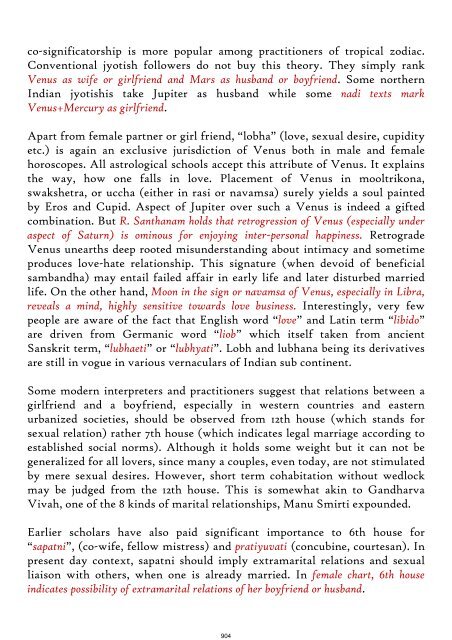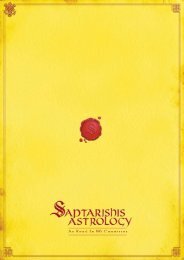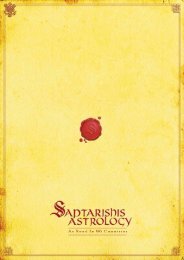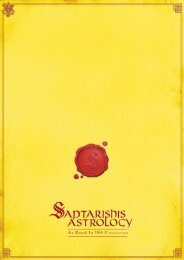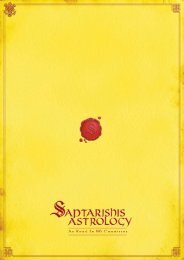SAVol8June2010Indian.. - Saptarishis Astrology
SAVol8June2010Indian.. - Saptarishis Astrology
SAVol8June2010Indian.. - Saptarishis Astrology
- No tags were found...
Create successful ePaper yourself
Turn your PDF publications into a flip-book with our unique Google optimized e-Paper software.
904<br />
co-significatorship is more popular among practitioners of tropical zodiac.<br />
Conventional jyotish followers do not buy this theory. They simply rank<br />
Venus as wife or girlfriend and Mars as husband or boyfriend. Some northern<br />
Indian jyotishis take Jupiter as husband while some nadi texts mark<br />
Venus+Mercury as girlfriend.<br />
Apart from female partner or girl friend, “lobha” (love, sexual desire, cupidity<br />
etc.) is again an exclusive jurisdiction of Venus both in male and female<br />
horoscopes. All astrological schools accept this attribute of Venus. It explains<br />
the way, how one falls in love. Placement of Venus in mooltrikona,<br />
swakshetra, or uccha (either in rasi or navamsa) surely yields a soul painted<br />
by Eros and Cupid. Aspect of Jupiter over such a Venus is indeed a gifted<br />
combination. But R. Santhanam holds that retrogression of Venus (especially under<br />
aspect of Saturn) is ominous for enjoying inter-personal happiness. Retrograde<br />
Venus unearths deep rooted misunderstanding about intimacy and sometime<br />
produces love-hate relationship. This signature (when devoid of beneficial<br />
sambandha) may entail failed affair in early life and later disturbed married<br />
life. On the other hand, Moon in the sign or navamsa of Venus, especially in Libra,<br />
reveals a mind, highly sensitive towards love business. Interestingly, very few<br />
people are aware of the fact that English word “love” and Latin term “libido”<br />
are driven from Germanic word “liob” which itself taken from ancient<br />
Sanskrit term, “lubhaeti” or “lubhyati”. Lobh and lubhana being its derivatives<br />
are still in vogue in various vernaculars of Indian sub continent.<br />
Some modern interpreters and practitioners suggest that relations between a<br />
girlfriend and a boyfriend, especially in western countries and eastern<br />
urbanized societies, should be observed from 12th house (which stands for<br />
sexual relation) rather 7th house (which indicates legal marriage according to<br />
established social norms). Although it holds some weight but it can not be<br />
generalized for all lovers, since many a couples, even today, are not stimulated<br />
by mere sexual desires. However, short term cohabitation without wedlock<br />
may be judged from the 12th house. This is somewhat akin to Gandharva<br />
Vivah, one of the 8 kinds of marital relationships, Manu Smirti expounded.<br />
Earlier scholars have also paid significant importance to 6th house for<br />
“sapatni”, (co-wife, fellow mistress) and pratiyuvati (concubine, courtesan). In<br />
present day context, sapatni should imply extramarital relations and sexual<br />
liaison with others, when one is already married. In female chart, 6th house<br />
indicates possibility of extramarital relations of her boyfriend or husband.


